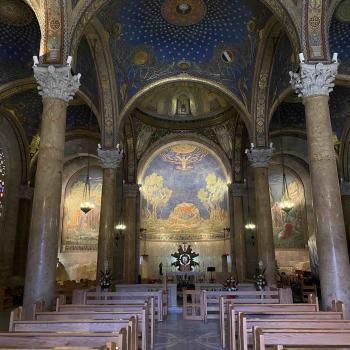The ancient theologian and once bishop of Cyrus, Theodoret, begins his series of questions on Leviticus by making a rather confident theological assertion: “I suppose not even a fool would deny that God is without need.” [i] But if the Almighty does not require ritual supplication for His own supernatural benefit, then why establish the sacrificial system for the Israelites? Theodoret suggests the following:
1. He permitted the sacrifices already practiced to

safeguard from unholy reverence.
Those Israelites who became enslaved under the Egyptians learned to participate in sacrifice to idols—not hollow statues or symbols, but demons as the bishop of Cyrus suggests—and so the Lord knew His people’s blasphemous inclinations, directing their sacrificial tendencies toward the proper worship of the One True God who brought them out of captivity on eagle’s wings.
2. He proclaimed those animals deemed holy by the Egyptians to be offered.
God continued to guide His people to Himself by designating certain animals as worthy to be offered unto Him. These creatures, and others, were regarded as divine in some manner by the Israelite oppressors, or at least their likeness (think Hathor, who was often depicted as a cow goddess). Such pagan symbols God rendered unclean or worthy of being ritually slaughtered on account of the false holiness that encircled them; the Hebrews were taught yet another lesson in proper monotheistic worship, according to Theodoret.
3. He used the biblical text associated with the sacrificial system to speak of ethical lessons and higher truths.
This last category is not explicitly stated in the bishop of Cyrus’s Questions on the Octateuch, but is heavily implied in the discourse that follows his initial question; it is this point that is most crucial to this post. According to Sten Hidel, in his article regarding the Antiochene exegetes of late antiquity, “Theodoret in all essential aspects adheres to the principles of the Antiochene School,” [ii] a hermeneutical method which traditionally emphasized a literal interpretation of sacred Scripture.
But the expositor of Cyrus did not omit allegory from his repertoire entirely; it was a critical tool that allowed the bishop to see the line of continuity that connects the New Testament to that of the Hebrew Bible, and to contemplate additional meanings now applicable to those in the Church who have proclaimed faith in the final sacrifice by which all sin has been atoned. Theodoret saw the efficacy of God’s holy revelation to be eternal and eternally relevant to himself and his contemporaries and he followed this celestial trail; he sought to comprehend the lessons God wanted to teach his people through the descriptive text of the sacrificial system.
Theodoret’s Expositions on Sacrificial Law
“The sacrifice for sin was offered without oil and incense, for those seated in the darkness of sin have no nurturing light, and those who ought to groan no joy—as the prophet says, oil makes the face joyful—and those who have not yet cast off the stench of wickedness no pleasant fragrance.” [iii]
In the selection above, one can witness Theodoret as he hones in on an ethical rendering for which the absence of incense and oil was necessary when conducting a sin-offering by the ancient Israelites. To land upon such a moral teaching occupying a hermeneutical space between a plain interpretation and that of a heavily allegorized one, the bishop makes use of a common interpretive technique that was harnessed by the Antiochene school, Theoria. In this instance, the exegete takes his “starting point in the sensus litteralis (literal sense) and never leaves it. The historical sense of the text is transcended by the higher sense…but it is not abolished.” [iv]
Truly, the sacrifice was to be performed without oil and incense simply because the LORD decreed it to be as such, but additionally, in His wisdom, He sought to teach a moral lesson to those fulfilling the function if they were doing so with proper intention—or perhaps as a method to help facilitate proper intention. The individual atoning for his/her sin should not do so with a bright spirit, for they have transgressed the One who gave them life; they should reflect upon the atrocity that they have committed against God.
And so, just as these words describing correct sin-offerings were to cultivate right intention during the act of sacrifice by those worshiping before the destruction of the temple, they also worked and continue to work to teach God’s people in a post-temple environment to have right intention when coming to the One in prayers of thoughtful repentance.
“I do not think I am out of order in remarking that those who offer themselves to God resemble the various animal victims. Those embracing a life free of possessions and worries devote themselves wholly to the God of the universe and turn themselves into holocausts and whole victims…Some offer the gentleness of sheep; others, in the manner of obedient calves, gladly bear the easy yoke of the Lord; still others following the apostolic law, your abundance meeting their need, (2 Cor. 8:14) imitate goats and, from their budgetary surplus, provide milk, as it were to the poor…Others adorn their mind with simplicity and innocence in imitation of young pigeons, who live in innocence…” [v]
In this passage, Theodoret displays, in my opinion, a textbook allegorization of the biblical text, adhering to Hidel’s suggestion that the bishop “is an eclectic writer and often brilliant in his capacity of holding a middle course between the radicalism (literalism) of Diodore and Theodore on the one hand and the excessive symbolical interpretations of the Alexandrian School on the other.” [vi] Theodoret does not shy away from symbolic renderings when necessary, but more often adheres to the plain meaning or to that of an interpretation that lies between—which was discussed in the commentary to the prior passage (Theoria).
According to the spiritual leader of Cyrus, each species of animal that was designated for a sacrifice unto the LORD also prefigured those in the Church who would soon consecrate their whole being to be rendered as an offering to that very same God. Here the bishop finds the thread tying this teaching in Leviticus to its counterpart in the New Testament. For those in the Spirit and not under the Law—which typifies the Church as Theodoret would suggest—such persons should bear the fruit of gentleness as the lamb, self-control as the calf and the young pigeons, kindness as the goat in giving freely to others, and the like.
These fruits of the Spirit were taught by the apostle Paul in Galatians 5, but also through an allegorization of the descriptions of the sacrifices in the Torah. Theodoret insists in his reading that some more readily offer their gentleness, or self-control than others, or perhaps they are gifted in greater measure with regard to one category over another, and should then offer in accordance with the gifts that they have received. Thus, some are called to profound self-control, and likewise offer God the sacrifice of holy chastity, imitating their master, Jesus Christ.
[i] Theodoret. The Questions on the Octateuch Vol 2. Edited by John Petruccione. Translated by Robert C. Hill, Catholic University of America Press, 2007, 3.
[ii] Hidal, Sten. “Exegesis of the Old Testament in the Antiochene School with its Prevalent Literal and Historical Method.” In Hebrew Bible / Old Testament: The History of Its Interpretation Part 1: Antiquity, edited by Magne Sæbø, 543-568. Göttingen: Vandenhoeck & Ruprecht, 1996.
[iii] Theodoret, Questions, 7.
[iv] Hidal, “Exegesis of the Old Testament.”
[v] Theodoret, Questions, 7.
[vi] Hidal, “Exegesis of the Old Testament.”












